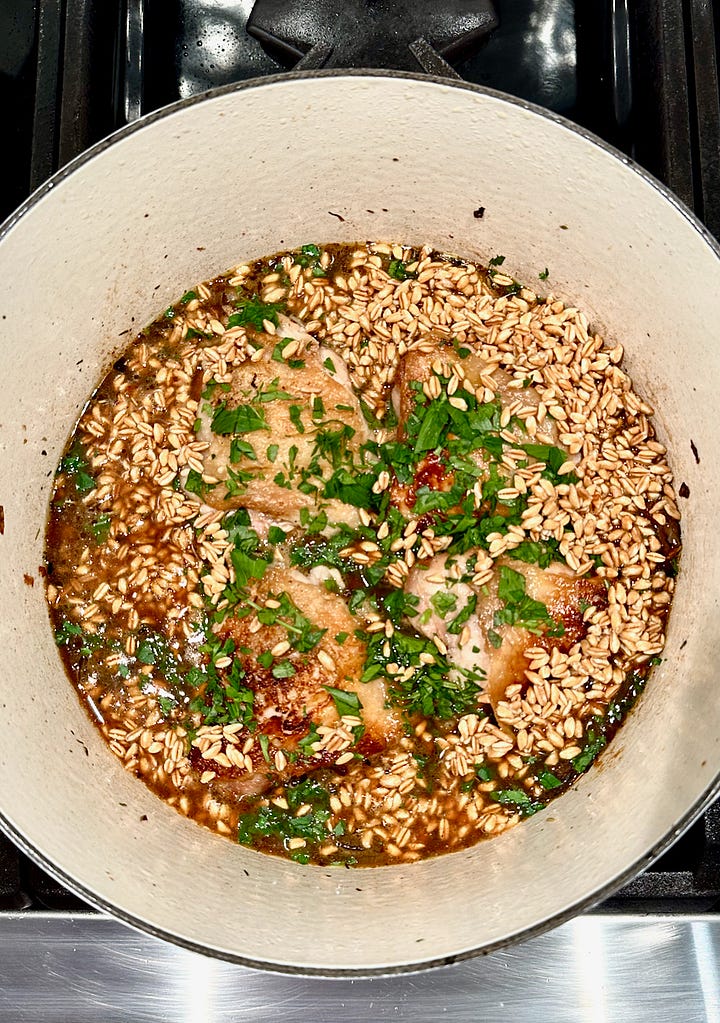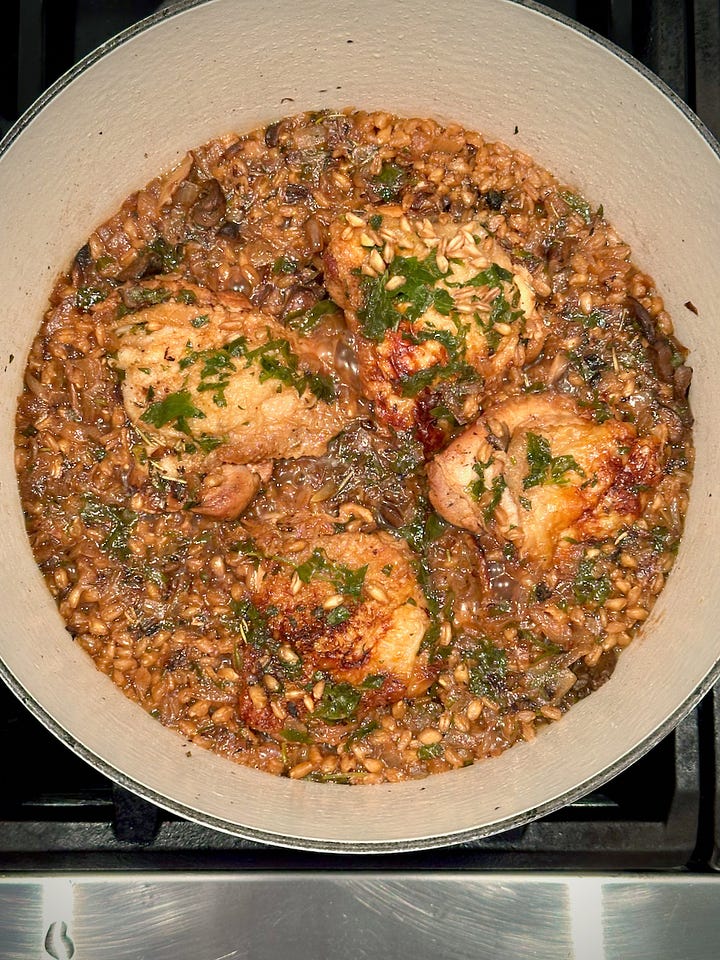UnHoly Roman Love and Regret, Longevity Vitamins, Your Brain on Mushrooms
Roman accounts of mushroom orgies have surfaced, a thrill-seekers union of food, humanity, and fungi; Cider-Braised Chicken with Farro and Mushrooms to ward off winter blues
When men ascend to power, they inevitably attract two things…younger women and enemies.
Having met two failed betrothals before his first of four failed marriages and numerous unfulfilling affairs, Claudius, Emperor of Rome, was indisputably unlucky in love.
But, then again, Claudius was not one to leave a paramour breathless, at least in the traditional sense.
“He had a 'nervous tic head,” recorded the ancient historian Tranquillus. “which was apparent at all times but especially when he exerts himself to the slightest extent.” Not only was he prone to inappropriate outbursts of laughter, he walked with a limp, slobbered when he spoke, his nose ran interminably, and he suffered partial deafness likely due to childhood measles.
M, 37, seeks companionship, wicked sense of humor, good rhythm. loves fine dining and wine, more spectator than athlete, promotion track

Unattractive as he was, his spastic shaking and secretions were more an optics problem.
His physical ailments worked to his advantage, as he seemed to be a beta, a non-contender, an uncharismatic doormat.
Claudius was perceived as no threat to his predecessors, Tiberius and Caligula, and, thus, having escaped the political jockeying of the Roman Empire that usually resolved with homicide, he ascended to the throne AD 41.
Claudius’s first betrothal to his distant cousin, Aemilia Lepida, dissolved when her unsavory parents conspired against her great-grandfather, the Emperor Augustus. Claudius called off his engagement to such a risky proposition. Misfortune followed when his second fiancé, Livia Medullina Camilla, suddenly collapsed dead on the day of their wedding. A political arrangement, his first marriage to Urgulanilla, Livia’s confidant, ended in divorce after accusations Urgulanilla murdered her sister-in-law and conceived a child with Claudius’s trusted former slave.
You might say he had a bad picker, his poor taste in women followed misstep after misstep.
A marriage on the rebound was no better salve. Tired of wife #2’s hen-pecking, he divorced her as an emotional liability and married #3, Valeria Messalina. Valeria was described as a stay-up-late party girl with an insatiable, roving sexual appetite. She left a trail of conspiratorial poisonings in her wake targeting any who crossed her or for whom she had no use. The last straw came while Claudius was away on “business” at which time Valeria brazenly announced a marriage to a rival Senator and her latest new conquest, Silius. Summarily, wife #3 was dispensed.
With so much to cause agita, Claudius took to the bottle. Numerous medical journal reports make a sport of scouring ancient Roman texts for clues to diagnose his many ailments and the events that ensued. Wrote Dr. William Valente:
“He ate and drank in excess regularly, rarely leaving his dining room until he was “stuffed and soaked.” Thus, it was not unusual for him to fall asleep immediately after dining and to have to be carried unconscious to his bed. He gained considerable weight in later years and complained of heartburn that was so frequent and severe that he contemplated suicide as his only means of relief.”
Caveat Cenans! William A Valente MD, Richard JA Talbert, PhD, Judith P Hallett, PhD , Philip A. Mackowiak, MD Vol 112 The American Journal of Medicine April 1, 2002
Mushrooms or boleti, Amanita caesarea, were a favorite dish of Claudius’s. Roman banquet hosts embraced these hand-foraged delicacies to put their wealth on display.
A skillful forager is required, one that can be trusted. Amanita caesarea is difficult to distinguish from other toxic members of the genus, Amanita muscaria and the “Death Cap,” Amanita phalloides, responsible for 95% of fatal mushroom poisonings today and a favored means to poison an enemy back then. In 2024, the FDA required a California-based company to recall Diamond Shruumz, mushroom chocolate bars intended for microdosing. After several hospitalizations, testing revealed active ingredients derived from Amanita muscaria as well as psilocins classified as controlled substances.
Roman banquets were lavish affairs for the elite with exotic produce, forbidden foods, wine decadently flowing, courtesan dancing girls, gladiatorial fights, trained leopards and lions prowling; an ostentatious showing meant to titillate the senses.
Roman accounts of mushroom orgies have surfaced, a thrill-seekers union of food, humanity, and fungi.
According to Pliny, the potential threat of wild-foraged mushrooms’ toxic potential were part of the “pleasurable poison’s” attraction, fitting well into the wanton revelry. Of course, one had to assume that the palace taster was a reliable safeguard.
Until one gluttonous evening led to Claudius’s undoing.
Claudius had consumed a large quantity of wine and food, and was served up a dish of caesarea mushrooms by his then wife #4, Agrippina. Complaining of severe stomach pain, he became unconscious. After awakening and feeling somewhat better, he shortly took a turn for the worse. We are told that a palace physician induced vomiting with the tip of a feather before the Emporer collapsed dead a final time.
And with that, Nero, Agrippina’s son, ascended as Emperor; though only 17, he had a couple of years on Claudius’s natural son, Britannicus, not yet in possession of the rites of adulthood. Joked Nero, perhaps complicit in a devious plot to secure the throne launched by his mother Agrippina, “Claudius became a God by eating the food of the Gods, a mushroom.”
Agrippina, it is theorized, made sure her husband’s portion contained a naturally toxic mushroom, or laced the dish with the Death Cap’s toxic juice, or delivered the poison via the tip of the feather that the physician used to induce vomiting.
So, perhaps there is a parable here that the citizens of Rome have left us.
The princeps ruled over a society of sound of economics, civics, and free flow of ideas, but not one built on trust. Horace's satire has a warning, especially for hedonistic eaters, “Field-mushrooms have the finest nature, others are not to be trusted.” Trust only the natural, those grown in the open and gathered in the sunlight; those procured from dark places may be a risky proposition to one’s health.
In place of dark places, substitute lack of transparency. In place of mushrooms, substitute hydroponically grown lettuce, farmed fish, raised cattle, engineered heirlooms, or plant-based meat substitutes. Better yet, substitute Doritos, Bic Macs, french fries, Chick-fil-A, the “pleasurable poisons” of today.
Whether it’s your wife who supplies a toxic mushroom or the food brands you purchase, eating food someone else has gathered puts your life in their hands.
With each purchase, it’s worth pausing to ask: As Horace cautions, those mushrooms —“'Who will stand surety for them in the marketplace?” Do you trust the hands that food has passed through? the fields where food was gathered? We are reminded how health and food are inextricably linked.
The ‘Longevity Vitamin’
Neither animal. vegetable, nor mineral, fungi stand in a kingdom all their own. As a result, they offer bioactive nutrients that differentiate them from the plant kingdom. That may be why mushroom-eating, in general, is linked to lower risk of all-cause mortality.
Vitamin D2 and D3
Mushrooms are the sole “plant food” to offer a source of Vitamin D. Limited sun exposure during winter and spring and climate warming forcing more time spent out of the sun exacerbate needs. Even with supplements, diet remains essential to meet adequate Vitamin D in order to maintain health and prevent musculoskeletal, metabolic, cardiovascular, malignant, autoimmune, and infectious diseases. It plays a role to help calcium absorption in the gut and to regulate adequate blood serum calcium and phosphate concentrations to enable normal bone mineralization.
There is speculation that up to 40% of the population falls short of adequate Vitamin D. With rising vegetarian/ veganism and the decline in milk and dairy intake by Gen Y and Z, these groups are susceptible to insufficiency. The United States Dietary Reference Intakes (DRIs) recommend an RDA of 600 IU daily, 800 IU for age >70 although there are varied recommendations from health agencies across the globe.
Who needs to supplement Vitamin D?
To address rising needs and the scarcity of Vitamin D in foods, the Endocrine Society issued a July 2024 guideline supporting empiric Vitamin D supplements for select groups:
Children age 1-18 to prevent rickets and lower risk of respiratory infections
adults over 75 to prevent osteoporosis and promote longevity
pregnant women to prevent preeclampsia and lower preterm birth and infant mortality rates
and those with high risk pre-diabetes to delay progression to diabetes.
To meet the current daily recommendation from diet would require 4 ounces of fish, 4 cups of milk, or up to 10 servings of fortified foods which most don’t meet.
Mushrooms and salmon are the two greatest sources of vitamin D2 and D3 in American diets. Other top food sources are fish and shellfish ( 61.59%), eggs (17.75%), meat (8.03%), milk (4.25%), beans and lentils (3.93%), and grains (3.84%).

Ergosterol, a natural cholesterol-like compound found only in mushrooms, can be converted to pre-vitamin D2 with UV light or sun exposure and then thermally isomerised to vitamin D2. The mushroom gills harbor twice the concentration of ergosterol as the cap.
Cultivated mushrooms that are grown in greenhouses or in darkened growing facilities result in scant mushroom Vitamin D2 content that has become nearly nutritionally irrelevant. But, fortunately, mushrooms are living, breathing organisms that can manufacture Vitamin D even after you bring them home.
In the know: You can enrich mushrooms for Vitamin D at home
Place your mushrooms gill-side up in natural sunlight- outside in direct light on aluminum foil or in a window for 30 minutes of exposure. Some retailers sell Vitamin D-enriched mushrooms (sold under the Sun Bella line by Monterey Mushrooms) which boost content via pulse UV light exposure before they enter the supply chain. These products will be designated as ‘enriched’ on their labels.
Your brain on mushrooms: Ergothioneine
Ergothioneine, also known as Ergo, is another ‘longevity vitamin’ and one of the most efficient and potent antioxidants in the human diet. Mushrooms that contain the highest amounts of ergothioneine include King oyster, maitake, oyster, and shiitake varieties. Ergothioneine’s actions are not fully understood; however the anti-inflammatory compound, also found in red and black beans, is considered to exert anti-aging effects as a high efficiency systemic anti-oxidant: it improves memory, delays cognitive decline and vascular dementia, and has been linked to enhanced neurotropins necessary to maintain flexible brains. Neurotropins enhance cognitive resilience especially as networks affected by aging rely increasingly on recruiting circuits to make them work more efficiently.
A few culinary tips:
Clean mushrooms of attached growing media, use water sparingly
Dry frying and short cooking times are best for Vitamin D retention
Don’t add salt before heating which can draw out moisture; season lightly and add garlic, shallots, tarragon, thyme, onion, chili flake, oregano, scallions or wine after the mushrooms brown and release all their liquid.
What do women physicians feed their families?
Michelle Seguin MD, a Family Medicine & Lifestyle Medicine physician and avid gardener, said, “Something new we’re trying this month is the Chipotle Sweet Potato and Mushroom Breakfast Tacos from this month’s Savor the Seasons Cookbook Club! We’re a very pro-mushroom family—we love foraging for morels in the spring, and we even grow our own shiitakes on logs in our garden.” Check out her newsletter!
In my kitchen, I’m working to experiment with different mushroom varieties…king oyster and champignons turned up in my seasonal farm share and local gourmet “blends“ are available in my market. They add a wonderful meatiness to vegetable-forward meals; swap them for all or half of the ground beef in your lasagnas and casseroles. I love the earthy, umami flavor mushrooms add to my Dutch Oven stews and braises. Baby Bella are my workhorse cremini with a texture that stands up to slow cooking. I sauté these with greens—kale, chard, or collards. White button mushrooms get a marinade treatment of warm olive oil, garlic, pepper flakes, oregano, and vinegar before stocking in my fridge to add to salads. I add delicate shiitake with scallion and kabocha squash to miso broth —-this can revive my spirit after a long day. You’ll find lots of additional recipes for inspiration at www.ellenkornmehlmd.com and in the Eating and Feeding Archive.
For Game Day: New Mexican Duck and Bean Chili with Chocolate
For an easy weeknight dinner:Mushroom Ma Po Tofu with Gochujang
Best pasta:Toasted Kasha with Garlicky Mushrooms and Farfalle
Get your Greens: Red Russian Kale and Baby Bella Mushrooms
Best bistro meal: French Puy Lentils With Mushrooms and Fried Egg
Best One Dish: Leek, Apple, and Mushroom Barley Baked Risotto
Cider-Braised Chicken with Farro and Mushrooms
Here’s a Dutch Oven one-pot braise to chase away the winter chill. I braised chicken thighs in cider and added mushrooms for rich, umami flavor. The rich texture and nuttiness of farro elevate this warming stew. Eat with a good helping of greens and enjoy!


2 Tbsp olive oil
2 onions, coarsely chopped
4-6 bone-in chicken thighs
5 ounces mixed mushrooms like Baby Bella, shiitake, oyster mushrooms, sliced thin
1/2 cup farro
1 cup apple cider
1/2 cup white wine (may substitute chicken or vegetable broth)
1/2 cup water
1 teaspoon herbs de Provence
6 peppercorns
1 bay leaf
3 Tbsp flat-leaf Italian parsley, minced
My recipes minimize salt, season as you need
Heat 2 Tablespoons of olive oil in a heavy-bottomed casserole or deep skillet. Place the chicken thighs in the pan, skin side down, and brown 6-7 minutes until the skin is caramel in color. The thighs should easily release from the pan. Flip each thigh over and cook until the other side browns. Remove the thighs to a clean dish.
Scrape any bits in the pan into the liquid. Add the chopped onions and sauté, stirring frequently, until golden in color.
Add the mushrooms to the pot and continue to sauté 5-6 minutes until the release their liquid and begin to brown. Once the liquid evaporates, add the peppercorns and herbs de Provence, stirring into the mixture.
Pour 1 cup of cider, 1/2 cup white wine or broth, and 1/2 cup water into the pan. Stir to blend well and add the farro and bay leaf. Next, return the chicken thighs to the pan, skin-side up, nestling them into the liquid. Distribute the parsley over the thighs in the pan and bring to a boil.
Reduce the heat and simmer 40 minutes, covered, until the liquid is reduced and the farro and chicken are tender. A thermometer inserted into the center of the thighs should reach 165 degrees F. Serve in deep-rimmed bowls.
I’m on a mission to promote your health through nutritional literacy and to inspire young families, empty nesters, and busy people to cook more at home…share Eating and Feeding with someone you love this Valentine’s Day! Interested in a topic? please send me a message. I’d love to hear from you- like the post and tell me what you plan to cook tonight in comments.







An amazing weaving of history and cooking and health information! By the way, I eat the Portobello sandwich about once a week from Jersey Mike's. I'm hoping they are reasonably careful with their mushrooms!
Such a fascinating read, Ellen! As the story progressed, I had a feeling Amanita muscaria would make an appearance. Thank you for the thoughtful shoutout; I’m always inspired by these conversations around food, culture, and health. You weave all three together beautifully!